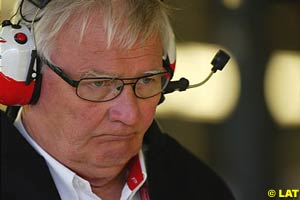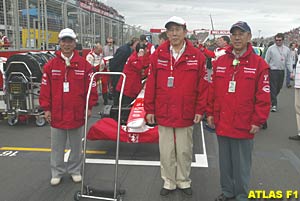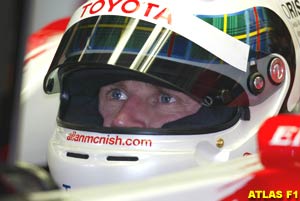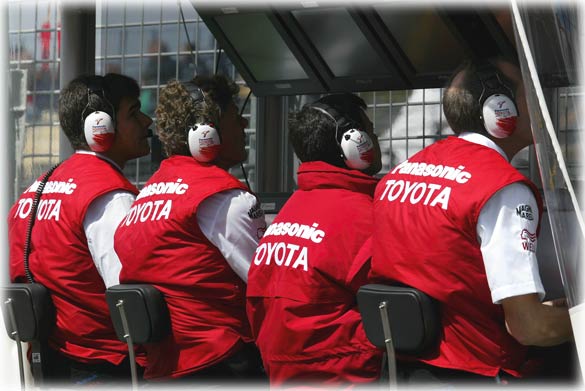
Atlas F1 Senior Writer
In the lead up to their first ever Formula One Grand Prix, Toyota said their only goal was to achieve respectability. In the hours after Sunday's race, it was obvious to all they have achieved this, and more. Roger Horton spent the entire weekend with the new team, talked to the principals and drivers, and brings back a look at what this memorable weekend looked like from the inside
It was on lap 38 that the Toyota dreams began to come true. That was the lap that Mika Salo's number 24 Toyota overtook the Minardi of Alex Yoong to take over sixth position. Sixth place pays one Championship point, a result that would have been unimaginable to anyone at Toyota until a first corner accident decimated the field, eliminating eight cars on the spot.
But could it have got even better? Salo was lapping over three seconds a lap faster than the fifth placed Minardi of Australian hero Mark Webber and there were plenty of laps left to make up what was then a huge deficit. As Salo closed in, his instructions from the 'brass' on the pit wall were clear - he was to go for the extra point whatever the consequences. In those dramatic moments, Toyota did more to shake off its stuffy conservative image than any multi million dollar advertising campaign could ever have done.
"Go - push, go to the maximum," were Salo's instructions from his race engineer Humphrey Corbett as the red and white Toyota pounded ever faster around Melbourne's Albert Park circuit. But it wasn't to be; with just three laps remaining, Salo slid wide on some oil in turn three as he attempted to pressure the rookie ahead of him, and his challenge was over. It might be some comfort that earlier this same patch of oil had almost accounted for second placed finisher Juan Pablo Montoya in his Williams.
In the end it didn't matter much. The sight of Toyota boss Ove Andersson sipping champagne as reporters and TV crews jostled around him told the story. Toyota had delivered, and at Melbourne at least, achieved the 'respectability' that they had consistently stated was their goal. "It was beginner's luck, but we will take it. I am just feeling over the moon," Said the very happy Andersson.
Initially the race had looked like a disaster for the Cologne based outfit, as both their cars were caught up in the first corner mayhem that resulted from Ralf Schumacher's collision with Rubens Barrichello's Ferrari. Salo's Toyota was hit from the rear and he was forced into the pits to change a rear track rod; as this took over three minutes, it looked to have put the Finn out of contention for the afternoon.
"The car was never the same after that," the Finn revealed after the race. "But always in Australia if you finish it's ok. It's a shame because we had a quick car and it would have been nice to actually race, and I think that beating Eddie Irvine would have been quite an easy job today."
"Don't worry, it's your turn next time," was the message from excited Toyota team members to the only man dressed in red and white who looked decidedly downbeat amongst all the celebrations in the moments after Mika Salo had taken the chequered flag and become a Toyota legend. After waiting a decade to make his Formula One debut, Allan McNish's race was over in just a few seconds.
"I didn't make a great start and I was holding the inside line," McNish recalled afterwards. "Then the accident started up ahead and cars started to spin in all directions. I took to the right to miss them and was forced to cut the corner and I ran across the grass - it was the only place that was free. That was all ok, I had the car slowed down, but as I tried to rejoin the circuit a car came from my left-hand side and hit me."
But McNish found it impossible to remain downbeat for long, surrounded as he was by all the backslapping and smiling Toyota personnel milling around the garage. The Scot was very pleased for his team and overall satisfied with the way they had coped with their first test under fire. "Very satisfying" was his overall verdict on a weekend that had gone so much better than anyone at Toyota had had a right to expect.
Backtrack to an overcast Thursday, as the teams were preparing for yet another seventeen race season long grind, and the scene down at the slow end of the pitlane looked very different, and you couldn't help but wonder just what Paul Stoddard, team boss of the Minardi team, must have been feeling as he looked over at Toyota's pre-race preparations.
Last year he shared the poor end of the pitlane with the struggling Prost outfit, and no matter how bad his own problems were, he could gaze out of his motorhome window and see a team whose problems were clearly worse. Now the Frenchman's equipe is no more, and into the neighbourhood has come the 800-lb gorilla that is the Toyota Formula One team, the world's third largest carmaker with reputedly the biggest budget of any existing team on the grid.
Make no mistake: the Toyota Motor Corporation is a massive company with the resources to get what it wants if it can be bought. Last year it produced over 5.5 million vehicles in some 24 locations, more than double the number produced by rivals like Honda, Renault or Fiat (owner of Ferrari) and its worldwide sales topped the 100 billion mark. No wonder F1 boss Bernie Ecclestone found time in his schedule to grace Toyota's launch last December. The entry into Formula One of this conservative Japanese giant marks the culmination of Ecclestone's long-term strategy of making the F1 circus the carmakers' natural habitat, and the implications of Toyota's entry for the future of the sport are enormous.
Toyota is seen as being boring. The cars they manufacture are sturdy and safe, but they incite about as much passion as a wet weekend in Blackpool. This has to change, and what better way to change it than for Toyota-built Formula One cars to mix with those sexy Ferraris and dashing Mercedes powered McLarens on the glamorous racetracks of the world in front of millions of potential customers?
But if the rewards are potentially huge, then so too are the risks. The whole F1 world has watched in amazement (or should that be amusement?) as the marketing men at Jaguar have stumbled from one PR disaster to the next, whilst their cars have gone slower than a rain delay at Lords. In Melbourne their fortunes dropped to an all-time low when they only managed to outqualify two cars - one a Jordan that hardly completed a flying lap, and the other a Minardi driven by a novice pay driver who was having a bad day.
On race day their blushes were spared when Eddie Irvine was promoted into the points by the elimination of most of his opposition in the first lap incidents, but no one believes that Jaguar were anything but extremely lucky in Australia, and Toyota are very aware of the potential damage to their corporate reputation should they follow in Jaguar's footsteps.
So in the lead up to their debut race, Toyota were determined not to get caught in the trap of over promising, and instead stated repeatedly that 'respectability' was their only goal. This was sensible, and all the Toyota team members in the lead up to their debut race in Australia had all been well briefed as to the importance of sticking to the script, avoiding at all cost repeating the mistakes of Jaguar.
Team boss Ove Andersson, speaking to Atlas F1 alongside Melbourne's Yarra river during a pre race media gathering, once again reinforced his 'treat-us kindly' message. "This is a very very difficult task we have set ourselves. This will not be about instant success. I know that the factory in Japan is aware of this, and I also hope that you - the media - will also understand the difficulty. Don't kill us before we have a chance."
How nice it must have been for Andersson, then, that every Japanese face in the Toyota garage on Sunday afternoon wore broad smiles of complete happiness. For Orientals, 'face' is all-important, and the fact that their archrivals from Honda had such a bad day can only have added to their joy.
There was no question that despite a test programme that ran throughout all of last season and through the early part of this year - a programme that saw their cars complete over 26,000 kilometres of testing on eleven different circuits - Toyota were nervous about their debut race. Only once, during all those days of pounding around those tracks, had their car actually finished a full race simulation, so the fact that they got one car home in the race and generally had a weekend free of mechanical dramas was credit to all concerned.
There was much muttering about light fuel loads and the like, but the cars were reliable and the pit work had avoided the kind of disaster that could easily have visited a new team making such a high profile debut under such close scrutiny.
"Of course I am happy now," beamed Andersson after his car's engines had died for the day. But only the Swede's broad smile told you just how relieved he really was that the crucial first day had been completed successfully.
Saturday's qualifying session was also cut short by Melbourne's unsettled weather, reducing both cars to just one qualifying lap, but once again the red and white cars had done the business when it mattered. They were in the race, and you could almost hear the collective sigh of relief from the Toyota top brass in Japan, that the worst possibly ignominy - failure to qualify for their debut race - had been avoided.
But as the sun went down in Melbourne and the Toyota team members exited the paddock on Sunday, these earlier concerns were but a distant memory. They had been lucky but they had made the most of it. So organized and unflappable had the team been that they had made it look all too easy, perhaps even boring, only this time no one was complaining.
So how in the end can we judge Toyota's entry into Formula One? Perhaps we can apply to the issue the three rules of motor racing, as penned down by Atlas F1's Karl Ludvigsen:
1. You can be fast;
In Melbourne, Toyota passed Ludvigsen's test pretty well. They got one car to the finish; they were faster than many expected; and when Salo had been throwing his Toyota around in those final laps, his Toyota had certainly looked pretty good.
Debut races don't get much better than that, even if tougher tests lie ahead.
Meet the seven men who are sitting at the 'race control', on the pitwall:
Mika Salo was at Albert Park last year, but only as a spectator whilst carrying out some promotional work for his then new employers Toyota during the first year of his three-year contract with the team. This year, he was here to start his 93rd race, and to lead the Japanese giant into its great Grand Prix adventure. This was the calm before the storm, but for the experienced Finn there was little rest. The media road show was in full swing, but he seemed happy to go along for the ride.
Q: You have driven for Ferrari, the best team on the grid. Do you find that you are using this experience as a reference point?
Salo: That's a good point, because if we want to be good of course we have to try and beat them. I have seen how they run, how good the car is, and how the race team works. They have some quite unbelievable systems there, and that's what I have been pointing out to the people here.
Q: So you have been very active with Toyota in trying to work on all the operational systems they will need?
Q: Just what would you say is the car's strongest point right now?
Salo: I think that the strongest feature of the car is still at the factory. The car is very basic. When we got it in January we just ran it to make it reliable, we have not had the time to fit any 'go faster' parts yet. What we have now is a very good engine, overall the chassis perhaps lacks a little downforce, so for sure the car is not fast enough, but overall I am pretty happy with it.
Q: I know that you have only managed to complete one race distance coming into Melbourne.
Salo: Yes that's true, although we did a couple of others that were within a few laps. Since we started running the car we have only blown one engine - it's always something else that goes wrong, the gearbox or an electrical problem. But I am not so concerned about the reliability; I am more concerned about something else going wrong.
Q: Like what?
Salo: Pit stops, everything around the car, our strategy. You can practice and practice on your own but it's not until you have done things with twenty-two cars around, a lot of noise and tension. That's when we will see how we are.
Q: Does it bother you that realistically you will not be in a position to win another race in your career?
Salo: Not at all. I have been involved in something big. One day Toyota will be the greatest team in Formula One. I think that my work here has been very important and if I weren't here they wouldn't be so far advanced. I know that for a fact and I think my boss knows it also, and so that makes me very happy. So I tested all year for me, because I knew that I would be able to use the information I found for myself.
I am the sort of person that never gives up. I was racing for Tyrrell for three years. Everybody knew that you couldn't win a race driving for them. But in every race I went into, all seventy of them, I sat in the car and thought that I could win this race.
Q: Do you think it would have been better if you had a more experienced teammate?
Salo: Maybe in some points yes, but in other points no. If I had an experienced teammate it might have been difficult to work together as a test team, because you start competing already even when you are just testing and you can bring the whole team down, because you start hiding things from each other so you can use it in the next race. I mean, if you find something really good in testing you are going to keep it to yourself so you can use it against your teammate. It's a normal thing that is going on. But with Allan we can share everything to bring both of us up, because if we don't we both stay down.
Q: So you have a total sharing of information?
Salo: Completely, yes. I am helping him with the circuits, what to do, where the bumps are and all these things. After all, he is of more use to me when he is quick.
For a while it all seemed a bit unreal. In the closing stages of the Australian Grand Prix, whilst a Ferrari, a Williams, and a McLaren were heading for the their accustomed Podium finishes, most of the pressmen were down at the other end of the pitlane covering an unlikely battle playing out between newcomers Toyota and habitual strugglers Minardi for a fifth place finish.
 It was the stuff of dreams and the huge cheers that greeted the Minardi of Mark Webber securing his two points overshadowed the more muted celebrations from the mostly northern Europeans at Toyota. It is the Toyota way, after all. Like the way they make their cars, the Toyota celebrations were understated and predictable, but no less emotional, whilst the Latin temperaments at Minardi allowed their joy to be as unrestrained as the champagne spray.
It was the stuff of dreams and the huge cheers that greeted the Minardi of Mark Webber securing his two points overshadowed the more muted celebrations from the mostly northern Europeans at Toyota. It is the Toyota way, after all. Like the way they make their cars, the Toyota celebrations were understated and predictable, but no less emotional, whilst the Latin temperaments at Minardi allowed their joy to be as unrestrained as the champagne spray.
 Looking at the practice and qualifying times, perhaps Salo could well have handled Irvine's Jaguar in the race, but as Irvine was never actually contesting a place with anyone throughout most of Sunday afternoon we will have to wait until Malaysia to see if this is a possibility for Toyota.
Looking at the practice and qualifying times, perhaps Salo could well have handled Irvine's Jaguar in the race, but as Irvine was never actually contesting a place with anyone throughout most of Sunday afternoon we will have to wait until Malaysia to see if this is a possibility for Toyota.
 But if Toyota are so successful, just why have they decided to put their reputation on the line - not to mention many millions of dollars - in a high risk gamble to succeed in the toughest motor sport arena there is? The answer is simple and it's a six-letter word: 'boring'.
But if Toyota are so successful, just why have they decided to put their reputation on the line - not to mention many millions of dollars - in a high risk gamble to succeed in the toughest motor sport arena there is? The answer is simple and it's a six-letter word: 'boring'.
 When the race weekend started on Friday morning, there was naturally plenty of tension and sweaty palms inside the Toyota pits. But, by the end of a nerve-racking first day, the cars had, between them, completed 68 almost trouble free laps and they finished in sixth and sixteenth positions, in a wet-dry practice session, Mika Salo finishing ahead of Allan McNish.
When the race weekend started on Friday morning, there was naturally plenty of tension and sweaty palms inside the Toyota pits. But, by the end of a nerve-racking first day, the cars had, between them, completed 68 almost trouble free laps and they finished in sixth and sixteenth positions, in a wet-dry practice session, Mika Salo finishing ahead of Allan McNish.
2. You can finish;
3. You can look good.
Picture Perfect:
The Magnificent Seven on the pit wall

Sidebar: Q&A With Mika Salo
 Salo: Yes, we have been doing a lot of simulations, race starts and things like that. We have been going through them again and again just to get everything right. For sure it will go wrong somewhere, but at least if we learn from these experiences and don't make the same mistakes again it will be all right. So I have had a big role in not only driving the car, but in telling them what to do and what not to do, and everyday there is something new that I have to point out and say it's not the correct way.
Salo: Yes, we have been doing a lot of simulations, race starts and things like that. We have been going through them again and again just to get everything right. For sure it will go wrong somewhere, but at least if we learn from these experiences and don't make the same mistakes again it will be all right. So I have had a big role in not only driving the car, but in telling them what to do and what not to do, and everyday there is something new that I have to point out and say it's not the correct way.
Please Contact Us for permission to republish this or any other material from Atlas F1.
|
Volume 8, Issue 10
Atlas F1 Exclusive
The Stuff Debuts are Made Of
In the Spotlight: Engine Limitation
GP Review
The 2002 Australian GP Review
Technical Review: Australia
Commentary
The Beggars Rode!
Reflections from Melbourne
Spilt Milk
GP Stats
Qualifying Differentials
2002 SuperStats
The Charts Center
Columns
Season Strokes
Elsewhere in Racing
The Weekly Grapevine
> Homepage |